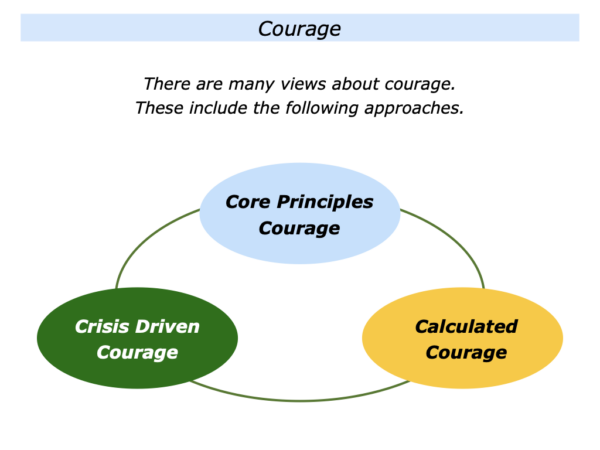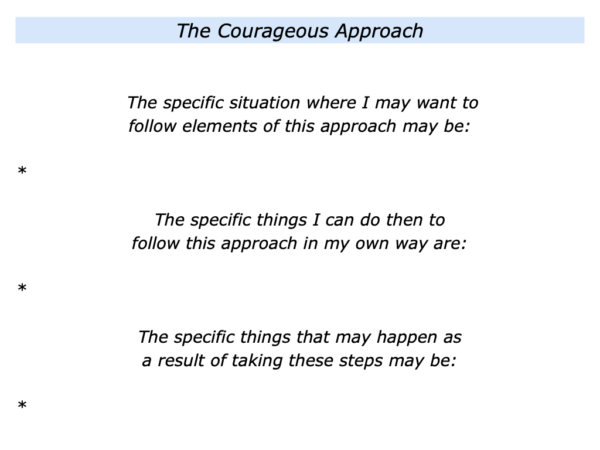
There are many views about courage. This piece looks at three approaches that people may follow when tackling challenges.
Core Principles Courage
This approach involves a person having the courage to follow their core principles. They also prepared to accept the consequences of following these principles in certain situations.
They may be following their moral compass, serving a cause or pursuing a mission. They aim to live in good faith and be true to themselves in difficult situations.
Such people go to their core when facing a specific challenge. They may then ask themselves the following questions
“What are the principles I want to follow in this situation? How can I translate these into practice? What may be the pluses and minuses of taking these steps? Am I prepared to accept the consequences?
Looking back, can you think of a situation when you followed elements of the core principles approach? This could have been in your personal or professional life. What was the actual situation?
What did you do then to follow your core principles and be prepared to accept the consequences? What happened as a result of taking these steps?
Calculated Courage
This approach is also sometimes called cold courage. It involves making a calculated decision that acting in a way that appears to be courageous is the best way forwards in a certain situation.
People who take this approach sometimes take the following steps when faced by a particular challenge.
They drain themselves of emotion, become quite cerebral and look at the situation in a logical way;
They clarify: a) the real results to achieve; b) the possible ways forward together with the consequences of each option; c) the other potential creative solutions;
They choose to follow the option that has the greatest chance of success and make their action plan for achieving the desired results.
They then become almost computer like when pursuing their chosen option. Moving into action, they follow their plan and keep reading reality. They build on what is working and find solutions to challenges.
Such people almost go into a trance. They may seem to hover above the situation, see themselves from above and keep pursuing the route most likely to achieve success.
Emerging from the situation, they report that what they did was the most logical thing to do. They may then allow themselves to catch up on the emotions that they ignored when exhibiting such cold courage.
Crisis Driven Courage
This is sometimes called hot courage. It involves spur of the moment acts of bravery to deal with a crisis. The adrenaline kicks in and the person throws themselves into action.
This may happen in certain critical situations. A person may confront an armed attacker, pull somebody from a burning car or put their own life on the line to save somebody.
This does not involve the absence of fear. They person may accept the feeling of fear but choose to act because doing so is better than failing to act. They sometimes go through the following steps:
They recognise what is happening and what may need to be done to affect the outcome;
They ask the question: ‘If not me, then who will do what is required in the situation?’ and, as result, they choose to act;
They then pursue their chosen strategy and do their best to achieve the desired outcome in the situation.
Such people may operate from the gut. When later told that they acted with bravery, they may say something like the following: “It was the obvious thing to do.”
Let’s return to your own life. Looking ahead, can you think of a situation when you may want to follow one of these approaches to courage? How can you then follow it in your own way?
If you wish, try tackling the exercise on this theme. This invites you to complete the following sentences.







Leave a Reply